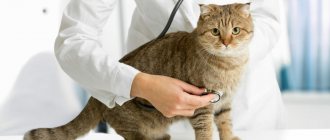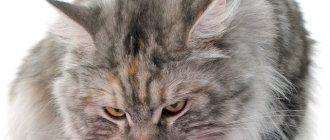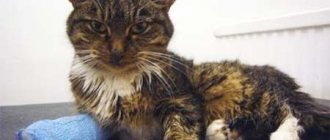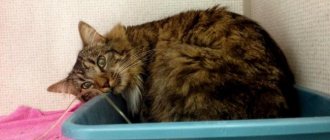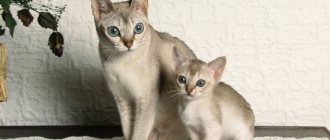Cats love cleanliness and take care of themselves. However, this does not relieve the owner of taking care of the pet; raising a kitten must be done from the very beginning of its appearance in the house. The owner must teach the pet to go to the toilet, not to chew all the things in a row and to play in a friendly manner. .
If the need arises, it will be necessary to perform an operation in a timely manner, which will require preparation and subsequent care. Throughout a cat's life, it is necessary to monitor its health.
Where to begin?
First, you should understand that a pet in the house is a full-fledged member of the family. If you decide to bring a kitten into your apartment, accept it as an equal member of the household. His opinion will have to be taken into account, so it is in your best interests to establish a trusting relationship with him. How to do it? Showing respect, of course!
To those who have not lived next to a cat, such advice will seem like an exaggeration. However, those who have been familiar with purrs for a long time know: a cat is a person. And this person will certainly show her temperament in the first days of your acquaintance with her.
How to prepare for the appearance of a feline in your home?
Before you bring a kitten or an adult animal into your home, you should prepare care products, a small veterinary first aid kit, and other things. What essential items do experienced breeders recommend purchasing?
- You will need bowls for food and water . You can purchase a bowl for dry and wet food.
- You will need a tray and filler for it. The filler is selected taking into account the age of the pet, its breed, and the length of its coat.
- In order to keep apartment cats clean, you need a hair comb and cat shampoo .
- Another care product for a domestic cat is a scratching post , thanks to which the pet will maintain a comfortable claw length.
- The cat will need a secluded place in the apartment to sleep and relax . You can buy a ready-made house or make it yourself. Instead of a house, a soft bedding or sofa will do.
- A pet can live in one house permanently, but it will still need to be taken outside occasionally - for example, for examination by a veterinarian. Therefore, you should purchase a basket or carrying container in which the animal will be comfortable. In a basket or cage, a cat can even travel with its owner.
Some items from the list are easy to make yourself - a house or bedding, a scratching post.
The few items listed are enough to properly and regularly care for your cat and ensure his comfort in the apartment.
Nutrition
The first thing new cat owners ask is: what to feed the cat? It all depends on how much free time the owner has. Depending on how busy the “chef” is, there are two options for the cat menu:
- Ready-made feed;
- Natural food.
Natural menu
If the owner prefers to cook food at home, then it is advisable to find a few minutes to prepare lunch for the pet. Because natural food is the ideal diet for a cat.
Feed your cat well
However, besides its usefulness, there are several disadvantages:
- Pickiness of a cat. Domestic cats often don't know what they want, so it may take you some time to get to know your pet's tastes.
- The high cost of natural products. As you know, cats are predators by nature. And predators need meat. Not every owner is ready to include an extra portion of meat products in their daily expenses.
- The need for vitaminization. If a cat eats natural food, it also needs vitamins. It turns out that Murka also needs to be stuffed with vegetables, which, by the way, she doesn’t want to eat.
Natural food and food from the table are not the same thing. By treating your cat with food from the table, you are harming the health of the animal.
In the wild (which is where our domestic cats come from), cats do not have the opportunity to enjoy fried, salty, smoked and sweet food. Therefore, even in apartment conditions, animals have no use for it.
Food without seasoning
If the owner decides to feed the cat natural food, it is necessary to ensure that it contains the following elements:
- Meat. The largest percentage of food in the bowl should be lean varieties of boiled meat and poultry;
- Fish should appear in a cat’s diet no more than once a week. Neutered pets do not need to be given it at all;
- Vegetables: carrots, beets, pumpkin;
- Dairy products. It is useful to treat your pet with kefir or fermented baked milk. Milk, on the contrary, should not be given;
- Once or twice a week, you can offer your cat a raw egg.
- Cereals. Porridges are also good for animals. Fiber in oatmeal, wheat and rice porridge has the best effect on digestion.
Ready-made feed
In conditions of constant employment, modern owners are increasingly choosing ready-made food as the main diet for their pet. It's convenient, profitable and fast. But what requirements should there be for a cat’s menu?
There are three types of ready-made food:
- Economy class;
- Premium;
- Super premium.
Economy class food is characterized by its low cost and availability. They can be found in any pet store.
The composition of such a product leaves much to be desired: no nutrients, no beneficial vitamins. But there are too many fillers and allergens. If you plan to feed your cat ready-made food, it is better to choose a higher quality option.
Economy food is only suitable for a one-time treat for a homeless cat, but not for a permanent diet.
Examples of economy class food: “Kitiket”, “Friskes”, “Whiskas”.
Economy class comes with premium food. Such foods contain a higher percentage of meat ingredients, however, there is still a high content of fillers that do not provide any benefit. This diet is more suitable as a main menu. But vitamin and mineral supplements are still necessary, since such feeds are not balanced.
Examples of premium lines: Sheba, Purina Van, Prevital. The cost of such manufacturers is average.
The best option for a domestic cat's diet is super-premium food. Such lines are balanced, so there is no need to give your pet vitamin and mineral supplements. It is also worth noting that super-premium food contains a large percentage of meat, which is optimal for cats.
The cat loves it when there is meat in the bowl
The disadvantage of this food can be considered its high cost.
Water
Place a cup of water near the bowl of food. For drinking, it is best to use regular clean “ash-two-o”. It is not necessary to filter your cat's water.
There are special requirements for a drinking cup. To prevent the bowl from absorbing foreign odors, it is best to use ceramics. It should be wide so that the cat's whiskers do not bend when drinking.
All cats are predators at heart, so they drink from puddles.
Metal bowls are also good, but cats do not always perceive such dishes adequately: the reflection on the shiny bottom can distract the cat from drinking.
When can I pick up a kitten?
To answer this question, you need to know some nuances about the development of kittens. As you know, a cat can have from one to seven kittens in one litter. This fact, as well as the breed, affects the weight of newborns, which ranges from 70 to 140 grams.
At birth, babies are almost completely hairless, completely blind and deaf. But with a well-developed sense of smell and touch. It is by smell that they find the mother cat to feed on her milk. Already on the fifth day of life, kittens begin to hear sounds around them. And on the tenth day they gradually open their eyes and begin to see.
After a few more days, babies can determine the direction of sounds
The animals learn to walk, not confidently and cautiously, and by the twentieth day they are able to move a short distance from the common crib.
By four weeks, kittens’ bodies are able to digest not only mother’s milk, but also additional complementary foods. At this age, following the example of a cat, they learn to lick themselves and go to a tray with soil or sawdust.
By the sixth week, most kittens become quite independent, they can play with their brothers and go to the litter box; milk nutrition is increasingly replacing complementary foods. By 7–8 weeks, the animals have all their milk teeth, their fur changes and their true color can be seen.
A very important condition in the development of a kitten is the presence of the mother and brothers to receive the very first and necessary knowledge in life. During the first months, all the kittens hardly leave each other a single step. They sleep, eat and play in a friendly ball. The cat raises them, teaching them to use a tray, a scratching post and to hunt, and, if necessary, bites especially mischievous children.
At about the age of two months, mother increasingly drives the babies away and sleeps on her own. They, in turn, get used to independent life and, under the guise of play, can hunt each other, lying in wait in ambush. By three months, the “fluffies” become completely independent, do not need mother’s milk, know how to use a tray and reach a weight of one and a half to two kilograms.
They get used to the people around them and play with them and toys without fear. During a period of carefree childhood, each kitten develops its own exceptional character.
From all this we can draw a simple conclusion that a kitten should be taken to a new home when it:
- able to feed independently;
- will be able to lick himself, thereby taking care of his hygiene;
- confidently uses a scratching post and litter tray;
- socially adapted, that is, he received proper education from a cat.
If these conditions are not taken into account, your pet may have problems with digestion and infectious diseases. He will be too timid and fearful or, conversely, overly aggressive, which can lead to dire consequences in the future. Will not be trained to use the litter box.
Thus, the most optimal age for changing a kitten's home will be about two to three months. Then the furry family pet will be properly raised and delight its owners, receiving love and affection from them. These requirements should be observed when the family consciously approaches the choice of a pet and is not limited in time.
But there are situations when a kitten is taken away from a cat before two months for a variety of reasons as a way to save “drowning”. In this case, the baby will need especially careful care and education, which he did not receive from his mother. For all the warmth and affection received, the kitten will definitely be infinitely grateful and will become another member of the family.
Video - funny boxer cat
Read how to treat otitis media in cats here.
Restroom
The next important point: the cat's toilet. There are also some requirements for the restroom. In the wild, a cat will not do its business where ill-wishers might find it. The same applies to the home toilet:
1. The tray should be in a quiet place . Where children are running around or human feet are trampling, the cat will not sit down. You can try to “change” her views, but the result will most likely be a pile in the wrong but calm place.
2. The tray should be comfortable . The cat must fit entirely into its “box”, and it needs space to rake in the result. Make sure the tray is spacious and has a sufficient edge.
3. The filler should not have a strong smell. Cats have a keen sense of smell, so the “smelly” litter can cause the cat to run under the sofa. It is also worth noting that some components of the filler often cause allergies in cats, so prefer natural types of raw materials.
4. Cleaning should be done as soon as possible after using the restroom. Cats love cleanliness, so they won’t go to a dirty litter tray.
5. Do not use aggressive chemicals for disinfection. Even though such products clean well, they completely discourage your pet from going to the strong-smelling toilet.
Some owners have a problem with how to teach a kitten to go to the toilet. If you take a little fool from the street, be prepared for the fact that you will still have to remove several unexpected piles. However, you should not give up on foundlings. You won't find a better friend than a rescued cat.
And you can easily train him to the tray:
- When the kitten starts to thrash around, put him in the litter box. Do this several times in a row if necessary;
- Protect the soil in your home pots from visits from the kitten, at least temporarily;
- Use special tools to show kids where to go to the toilet. Such sprays can be purchased at veterinary pharmacies and stores.
How to choose the right kitten and why should you choose cubs?
Cats are very special creatures. As you know, dogs get used to their owner, and cats get used to the house in which they live. It is best if the kitten is brought into the apartment at the age of 3-4 months and lives there all its life. He will consider this area his territory and will not make any attempt to get outside.
An adult cat will react to moving in the most negative way. At a minimum, he will begin to mark a new territory (and this will cause a lot of trouble for the owners), and at maximum, he may refuse to eat, begin to show aggressiveness and completely forget the way to the tray. In order to avoid such difficulties, it is best to buy a pet when it is small, and then the question of which cat is best to have in an apartment will not be so pressing.
And in order to choose the most worthy kitten in the litter, you must adhere to the following rules:
• Place of purchase of the animal.
The best option is to purchase a kitten from a specialized nursery. In such a place, purebred animals are bred and each kitten that appears is initially under the supervision of a veterinarian. From birth, he undergoes inspection, culling and has an appropriate passport confirming his pedigree. Of course, buying a bundle of joy in such a place is inexpensive, but the buyer is guaranteed to receive a quality product. Moreover, the owners of the cattery will always suggest the best cat breeds for an apartment and teach you how to properly care for a new family member. But it is best to refuse to purchase a cat from strangers or through an advertisement. It is easy to run into an animal with an unstable psyche or a congenital genetic disease.
• Pet's age.
If the future family member is less than 3 months old, then there is no need to rush into purchasing it. The kitten has not yet gone through “cat school”, the mother cat has not taught him all the wisdom, and he vitally needs mother’s milk. In addition, it is at the age of three months that the animal receives its first vaccination, and a passport is issued for it.
• Ease of movement and pleasant appearance.
Abyssinian cat – photo from the site www.catsofaustralia.com
It is well known that cats are very clean and tidy creatures. If the kitten's fur is in poor condition, it is wrinkled, does not shine and is not well-groomed, then the animal is clearly sick and is unable to care for itself. In addition, the kitten should not be too thin and not too fat. Any deviation from the norm is a reason for culling the animal. Also, the fluffy one should be playful and move easily. Kittens at the age of 3-4 months are very playful and active, and show commendable curiosity. If the baby is passive and constantly sleeps, then it should not be purchased. The future pet must be beautiful and active. In addition, this indicator should be taken into account especially when answering the question of what breed of cat to choose for a child.
• Ears, eyes and tail!
Ears, eyes and tail - these are the kitten's documents! The condition of these parts of an animal's body can tell a lot about its health. What breed of cat is best for a child? The one who is healthy and gets along well with children! If the animal’s ears and eyes are clean, without discharge or unpleasant odor, then the animal, at a minimum, does not have birth defects. Under the kitten’s tail is dry and clean - a guarantee of the absence of problems with the digestive system and gastrointestinal tract.
• A good appetite.
When you go to choose a future family member, you should take some cat treats with you. If the kitten happily accepts food from your hand, then there will be no problems with feeding at home. And if he refuses, then something is clearly wrong with the animal.
Which breed of cat to choose depends only on you, but a kitten of any breed must fully meet the above requirements.
Bathing
Cats don't swim, but they get dirty. Therefore, they need to be washed regularly. The frequency of water procedures depends on the lifestyle the pet leads.
Those cats that visit the street are advised to bathe at least once every two weeks. Even the cleanest cats visit garbage dumps, so don’t be fooled by your pet’s sparkling eyes and wash him regularly.
Truly domestic cats can be bathed less often. But still necessary. Short-haired purrs can be bathed once every three to four months. Long-haired cats need more frequent water treatments.
The frequency of showering is determined over time and individually for each pet.
There are situations when you need to buy a cat outside of the schedule:
- Approaching mating;
- Visit the exhibition;
- Shedding;
- Removal of fleas and other parasites.
You need to wash your cat with a special shampoo. This product will not dry out the animal’s skin. If you don't have cat shampoo on hand, you can use baby shampoo. But such a “replacement” should not be used often.
An unpleasant necessity
If you are going to bathe a long-haired cat, you must first brush it. This will save the owner from having to untangle the tangles after washing.
Compliance with feeding regimen
In order for the cat to get enough calories and not overeat, you need to feed the animal according to the schedule. The portions that a small kitten and an adult need are different, they largely depend on the breed, the pet’s disposition, and its activity.
An adult cat needs to be given food two to three times a day . Portions – 200 grams each. Kittens eat 5-6 times a day, smaller portions. Children should be given boiled chicken, cottage cheese, boiled eggs, and vegetable puree.
INTERESTING! One of the rules of proper feeding is maintaining hygiene standards. Bowls for water and food should be clean and it is recommended to wash them regularly.
The water should be changed frequently to ensure it always remains fresh. You should also choose products carefully - use only high-quality, fresh, safe ones.
Ears
Cats' ears need to be cleaned regularly. Murki are designed in such a way that they cannot take care of their ear canals on their own. Therefore, such a mission falls on the shoulders of the owners.
Once every three weeks it is necessary to clean the inside of the ear. This is done like this:
- A cotton swab is moistened with Vaseline;
- Then it must be inserted into the ear canal no further than 1 centimeter;
- Carefully clean the ear of accumulated wax;
- Next, you can treat the cleaned ear with hydrogen peroxide, also moistening a cotton swab in it.
The ears of a cat walking outside are more at risk. Therefore, they need to be inspected every day and cleaned more often than is the case with pet cats.
Education and training
Patience, calmness and affection - these are the three pillars on which the cat develops the necessary behavior and adherence to the rules. From an early age, your pet must be accustomed to a routine. This is achieved by regular walks, feeding and games held at certain hours. Trust is created through a calm conversation with the pet, with even gentle strokes. A loud voice and sudden movements can make him excitable and nervous.
The cat is a predator, so during play it can bite the hand, which gradually becomes a habit if this behavior is not stopped immediately. But in no case should you use rudeness and physical punishment for this. One way to stop biting is to press your hand down on the cat's mouth and tickle the gums with your finger. You can also simply say “no” in a stern voice and leave him for another room, stopping the game.
Sometimes unneutered cats exhibit sexual aggression towards others. In addition, during such a period he can mark his territory. Today there are many veterinary drugs that reduce sexual activity. But before using them, it is recommended to consult a doctor. If these remedies do not help, and the question of how to discourage marking the door and other objects in the house is still relevant, then the cat will most likely have to be neutered.
The animal's need for movement is satisfied through play, during which education occurs - the cat learns to sharpen its claws, respond to its name, and even follow commands. This means that the question of how to train a pet can only be resolved through play.
At the same time, the cat also needs walks outside. However, these wayward and freedom-loving animals tend to run away from their owner, which can be very dangerous for their life and health. Therefore, for walks it is necessary to use a harness. It should be the right size, fit snugly to the animal's body, and at the same time you can stick your finger under it. Before you put a harness on your cat, you need to let him get acquainted with this accessory, allowing him to smell it and even play. You need to get used to it gradually, putting it on first at home, without tightening it too tightly on the body.
Wool
Some breeds require more attention. These include long-haired cats. Such pets need to be combed.
This is necessary for several reasons:
- Brushing helps reduce shedding;
- Skin massage allows you to keep your cat's coat and dermis in the best possible condition;
- The amount of fur that the cat sheds on furniture is reduced.
For individuals with undercoat, there is a special brush that makes combing convenient and more effective - a furminator. Specially designed cheek teeth allow you to remove dead hairs without damaging living hairs.
Using the Furminator
For breeds with short hair or those without an undercoat, a regular brush or a rubber glove with “bristles”, which can be purchased at a pet store, will do.
It is enough to comb your pet once a week in normal condition and twice during periods of shedding. An individual schedule is drawn up for each cat separately.
What does a cat need?
Animals are able to very easily learn the norms of behavior set by their owners. The main thing is that the cat has everything necessary for a comfortable life: good nutrition, a place to rest and sleep, a litter box, and, most importantly, attention and love.
When a pet appears in a family, the question arises of where to place it. The ideal place would be a specially equipped house with a bed inside. There the animal will be able to retire, which is very important for representatives of the cat family.
Today, the choice of houses for them is huge - from simple mattresses of various shapes to structures of considerable size, where, in addition to a place to relax, there are a lot of devices for entertainment - platforms, ladders, hanging toys, etc. Such a set necessarily includes a scratching post, and often not even one.
If there is not enough space in the apartment for such a cat set, then it is not difficult for your pet to build a simple bed with your own hands. It can be sewn in the form of a round or rectangular pillow with sides on the sides, using an unnecessary blanket or plaid. Such a bed, placed in an old suitcase or a small wicker basket, will become a very cozy and warm nest for a cat.
Claws
Claws are the reason why many people refuse to own cats. And in vain. Today there are methods to help avoid scratched furniture and damaged wallpaper:
- Nail trimming is the easiest and cheapest method. Trim its claws once every two weeks and the cat will not feel the need to sharpen them on your sofa;
- Give your pet a scratching post. No less effective method. Murka will visit the area designated for manicure sessions and will stay away from the carpet and upholstered furniture;
- Anti-scratch. A new-fashioned device consists of plastic or silicone attachments for claws. A cat “dressed” in such caps will not spoil the wallpaper and corners.
Anti-scratch
Carrying
Cats do not like to move and change their usual habitat. However, this may be necessary when taking them to exhibitions, to nature, when the owners go on vacation, or to the dacha in the summer.
When transporting, you need to provide the animal with maximum comfort. It is better to transport cats over short distances in special bags where the animal’s head remains open. For longer transportation, it is advisable to use small bags or baskets (“carriers”), the front wall of which is a lattice door-window. The bottom should extend and be impervious to urine.
6 hours before departure the cat stops feeding. If the duration of the trip exceeds 24 hours, then the animal can be fed once during this time.
Cats can be transported by road, rail and air to various regions of the country. In this case, the cat owner must obtain a veterinary certificate. Violation of veterinary and sanitary rules entails the spread of dangerous infectious diseases. To import and export cats abroad, you should familiarize yourself with the veterinary legislation of a particular country.
Walks
Some owners prefer to keep their pets at home, not allowing the cats to get acquainted with the outside world. However, it has long been known that walking strengthens the immune system, so to the question “should I walk my cat” there is only one answer: yes.
Before you start walking your pet, you need to protect it:
- Only vaccinated animals are allowed for walking;
- During walks, the cat must wear an anti-parasitic collar;
- There is no need to walk your cat in damp and cold weather;
- After visiting the yard, the cat needs to wash its paws and inspect the animal for ticks.
If the walk involves wearing a special harness, then the cat should get used to such an accessory at home. You can walk your pet only when it moves freely around the apartment in its equipment, without trying to take it off.
Walk
Choose quiet and clean lawns for walks. It is unlikely that a cat will benefit from visiting a paved area of the yard or meeting dogs.
You should not let your cat near unfamiliar animals. Stray animals are often carriers of diseases, even if they appear healthy.
Unsterilized pets should not be left unattended. Not only will he try to procreate, but he may also pick up viruses that are inappropriate for a domestic cat.
Taking care of your health
Special literature, websites, and recommendations from veterinarians will tell you everything about caring for kittens. Much attention is paid to proper feeding and vaccinations. As you grow older, other questions arise.
- Cats can get sick; diseases of the kidneys, heart system, and bones require proper treatment . If signs of illness appear, you should immediately contact a veterinarian.
- Cats can fight simple diseases themselves, but this requires special herbs . In an apartment you can grow medicinal plants, a list of which can also be easily obtained from a veterinarian.
- Reproduction is part of the physiological needs of a cat. If there are no plans to breed kittens, you can undergo castration or sterilization at a certain age. Special tablets, infusions, drops solve the problems of sexual hunting; an artificial cat, sewn from scrap materials, can also be used to satisfy sexual needs.
- A cat, especially if it goes for walks, needs to be periodically cleaned of worms using special safe and effective products.
Even if the cat looks healthy and is active, you need to show it to the veterinarian from time to time. Some diseases do not appear immediately and can only be noticed by a specialist.
Scratching post for a kitten
The first thing you need to care for a Scottish kitten is to purchase a scratching post, preferably a more stable one. It is better if it is combined with different fur houses. It's actually very inconvenient in the sense that it's very difficult to clean.
- Many people use a very ordinary scratching post, which is very high. Some cats prefer to sharpen their claws at the top of the scratching post, while others, on the contrary, prefer to sharpen their claws at the bottom.
- It’s worth saying right away that the process of accustoming a kitten to a scratching post will require the owner to purchase more than one scratching post.
- In fact, animals have completely different needs for how exactly they will sharpen.
Some cats like to scratch off the floor, so they get a flat scratching post that just sits on the floor. Some cats, on the contrary, like to fully extend their body, so a tall one is suitable for them.
The final body
Before you start drawing the body, you should take a closer look at the original design:
- Now all the details are transferred to your drawing. Paws are drawn in front, each of which should have exactly three fingers;
- Looking at the next sketch, we begin to finish drawing the back of the cat, along with the tail and paws at the back. By adding just a few touches to the animal, you can get more pronounced features that are characteristic of such a cute cat;
- All that remains is to remove the extra lines that interfere with the resulting drawing. Now you can calmly and slowly draw a clearer and brighter outline;
- Color your image in your favorite color, making it more interesting and impressive.


